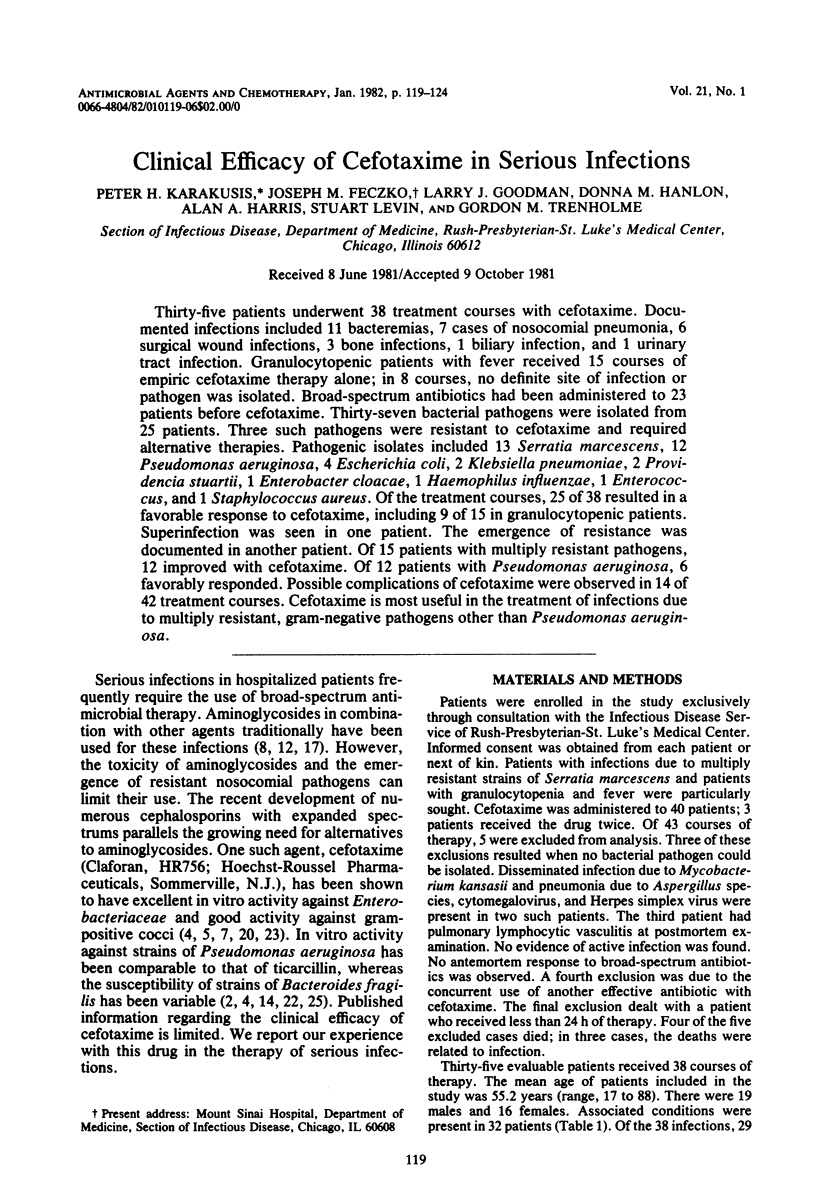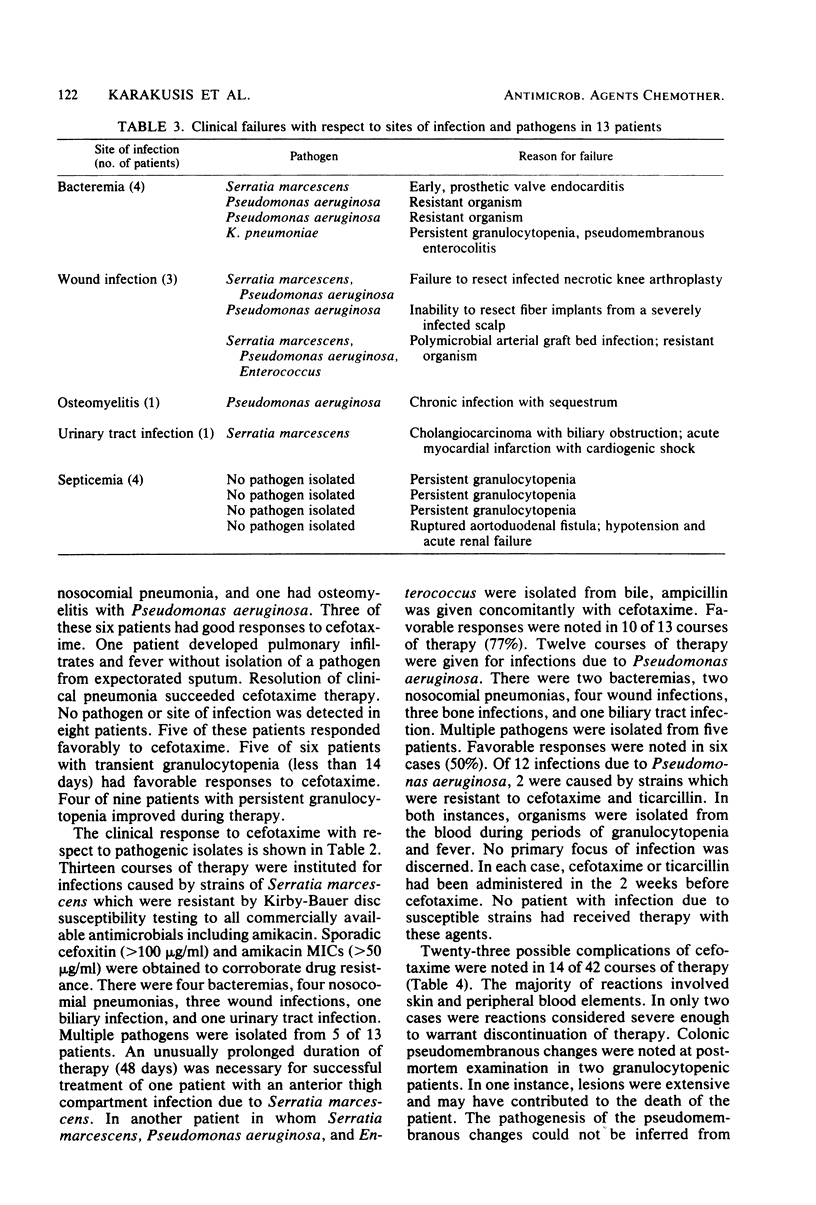Abstract
Thirty-five patients underwent 38 treatment courses with cefotaxime. Documented infections included 11 bacteremias, 7 cases of nosocomial pneumonia, 6 surgical wound infections, 3 bone infections, 1 biliary infection, and 1 urinary tract infection. Granulocytopenic patients with fever received 15 courses of empiric cefotaxime therapy alone; in 8 courses, no definite site of infection or pathogen was isolated. Broad-spectrum antibiotics had been administered to 23 patients before cefotaxime. Thirty-seven bacterial pathogens were isolated from 25 patients. Three such pathogens were resistant to cefotaxime and required alternative therapies. Pathogenic isolates included 13 Serratia marcescens, 12 Pseudomonas aeruginosa, 4 Escherichia coli, 2 Klebsiella pneumoniae, 2 Providencia stuartii, 1 Enterobacter cloacae, 1 Haemophilus influenzae, 1 Enterococcus, and 1 Staphylococcus aureus. Of the treatment courses, 25 of 38 resulted in a favorable response to cefotaxime, including 9 of 15 in granulocytopenic patients. Superinfection was seen in one patient. The emergence of resistance was documented in another patient. Of 15 patients with multiply resistant pathogens, 12 improved with cefotaxime. Of 12 patients with Pseudomonas aeruginosa, 6 favorably responded. Possible complications of cefotaxime were observed in 14 of 42 treatment courses. Cefotaxime is most useful in treatment of infections due to multiply resistant, gram-negative pathogens other than Pseudomonas aeruginosa.
Full text
PDF





Selected References
These references are in PubMed. This may not be the complete list of references from this article.
- Bauer A. W., Kirby W. M., Sherris J. C., Turck M. Antibiotic susceptibility testing by a standardized single disk method. Am J Clin Pathol. 1966 Apr;45(4):493–496. [PubMed] [Google Scholar]
- Bennett J. V., Brodie J. L., Benner E. J., Kirby W. M. Simplified, accurate method for antibiotic assay of clinical specimens. Appl Microbiol. 1966 Mar;14(2):170–177. doi: 10.1128/am.14.2.170-177.1966. [DOI] [PMC free article] [PubMed] [Google Scholar]
- Counts G. W., Turck M. Antibacterial activity of a new parenteral cephalosporin--HR 756: comparison with cefamandole and ceforanide. Antimicrob Agents Chemother. 1979 Jul;16(1):64–68. doi: 10.1128/aac.16.1.64. [DOI] [PMC free article] [PubMed] [Google Scholar]
- Delgado D. G., Brau C. J., Cobbs C. G., Dismukes W. E. In vitro activity of LY127935, a new 1-oxa cephalosporin, against aerobic gram-negative bacilli. Antimicrob Agents Chemother. 1979 Dec;16(6):864–868. doi: 10.1128/aac.16.6.864. [DOI] [PMC free article] [PubMed] [Google Scholar]
- Dosik G. M., Luna M., Valdivieso M., McCredie K. B., Gehan E. A., Gil-Extremera B., Smith T. L., Bodey G. P. Necrotizing colitis in patients with cancer. Am J Med. 1979 Oct;67(4):646–656. doi: 10.1016/0002-9343(79)90248-1. [DOI] [PubMed] [Google Scholar]
- Drasar F. A., Farrell W., Howard A. J., Hince C., Leung T., Williams J. D. Activity of HR 756 against Haemophilus influenzae, Bacteroides fragilis and Gram-negative rods. J Antimicrob Chemother. 1978 Sep;4(5):445–450. doi: 10.1093/jac/4.5.445. [DOI] [PubMed] [Google Scholar]
- Fu K. P., Aswapokee P., Ho I., Matthijssen C., Neu H. C. Pharmacokinetics of cefotaxime. Antimicrob Agents Chemother. 1979 Nov;16(5):592–597. doi: 10.1128/aac.16.5.592. [DOI] [PMC free article] [PubMed] [Google Scholar]
- Fuchs P. C., Barry A. L., Thornsberry C., Jones R. N., Gavan T. L., Gerlach E. H., Sommers H. M. Cefotaxime: in vitro activity and tentative interpretive standards for disk susceptibility testing. Antimicrob Agents Chemother. 1980 Jul;18(1):88–93. doi: 10.1128/aac.18.1.88. [DOI] [PMC free article] [PubMed] [Google Scholar]
- Hermans P. E. General principles of antimicrobial therapy. Mayo Clin Proc. 1977 Oct;52(10):603–610. [PubMed] [Google Scholar]
- Hutcheon D. F., Milligan F. D., Yardley J. H., Hendrix T. R. Cephalosporin-associated pseudomembranous colitis. Am J Dig Dis. 1978 Apr;23(4):321–326. doi: 10.1007/BF01072414. [DOI] [PubMed] [Google Scholar]
- Jorgensen J. H., Crawford S. A., Alexander G. A. Comparison of moxalactam (LY127935) and cefotaxime against anaerobic bacteria. Antimicrob Agents Chemother. 1980 May;17(5):901–904. doi: 10.1128/aac.17.5.901. [DOI] [PMC free article] [PubMed] [Google Scholar]
- Kurtz T. O., Winston D. J., Hindler J. A., Young L. S., Hewitt W. L., Martin W. J. Comparative in vitro activity of moxalactam, cefotaxime, cefoperazone, piperacillin, and aminoglycosides against gram-negative bacilli. Antimicrob Agents Chemother. 1980 Oct;18(4):645–648. doi: 10.1128/aac.18.4.645. [DOI] [PMC free article] [PubMed] [Google Scholar]
- Lang S. D., Edwards D. J., Durack D. T. Comparison of cefoperazone, cefotaxime, and moxalactam (LY127935) against aerobic gram-negative bacilli. Antimicrob Agents Chemother. 1980 Mar;17(3):488–493. doi: 10.1128/aac.17.3.488. [DOI] [PMC free article] [PubMed] [Google Scholar]
- Levine A. S., Schimpff S. C., Graw R. G., Jr, Young R. C. Hematologic malignancies and other marrow failure states: progress in the management of complicating infections. Semin Hematol. 1974 Apr;11(2):141–202. [PubMed] [Google Scholar]
- Moellering R. C., Jr, Swartz M. N. Drug therapy: The newer cephalosporins. N Engl J Med. 1976 Jan 1;294(1):24–28. doi: 10.1056/NEJM197601012940106. [DOI] [PubMed] [Google Scholar]
- Mouton R. P., Bongaerts G. P., van Gestel M. Comparison of activity and beta-lactamase stability of cefotaxime with those of six other cephalosporins. Antimicrob Agents Chemother. 1979 Dec;16(6):757–760. doi: 10.1128/aac.16.6.757. [DOI] [PMC free article] [PubMed] [Google Scholar]
- Neu H. C., Aswapokee N., Aswapokee P., Fu K. P. HR 756, a new cephalosporin active against gram-positive and gram-negative aerobic and anaerobic bacteria. Antimicrob Agents Chemother. 1979 Feb;15(2):273–281. doi: 10.1128/aac.15.2.273. [DOI] [PMC free article] [PubMed] [Google Scholar]
- Van Landuyt H. W., Pyckavet M. In vitro of cefotaxime against cephalothin-resistant clinical isolates. Antimicrob Agents Chemother. 1979 Jul;16(1):109–111. doi: 10.1128/aac.16.1.109. [DOI] [PMC free article] [PubMed] [Google Scholar]
- Wise R., Andrews J. M., Bedford K. A. LY127935, a novel oxa-beta-lactam: an in vitro comparison with other beta-lactam antibiotics. Antimicrob Agents Chemother. 1979 Sep;16(3):341–345. doi: 10.1128/aac.16.3.341. [DOI] [PMC free article] [PubMed] [Google Scholar]
- Wise R., Rollason T., Logan M., Andrews J. M., Bedford K. A. HR 756, a highly active cephalosporin: comparison with cefazolin and carbenicillin. Antimicrob Agents Chemother. 1978 Dec;14(6):807–811. doi: 10.1128/aac.14.6.807. [DOI] [PMC free article] [PubMed] [Google Scholar]


